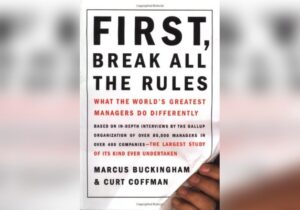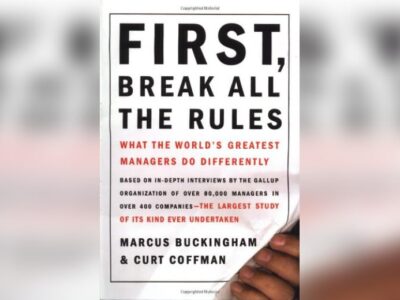Description
This book is a result of an exhaustive study undertaken by the Gallup organization involving 80,000 managers across a large number of industries exploring the concepts of employee satisfaction, selecting and maintaining good employees, and means of measuring employee satisfaction. The approach was revolutionary when published (1999) and has become a business classic because it challenged the status quo. First Break All the Rules asserts that the status quo is counter productive, and encourages management to adopt innovative approaches to employee engagement. There are four keys for unlocking potential in your employees: select for talents, suggest outcomes rather than direct control of process, focus on employees strengths and work around weaknesses, and finally find the right fit for your employees.
What separates the greatest managers from all the rest?
They actually have vastly different styles and backgrounds. Yet despite their differences, great managers share one common trait: They don’t hesitate to break virtually every rule held sacred by conventional wisdom. They don’t believe that, with enough training, a person can achieve anything he sets his mind to. They don’t try to help people overcome their weaknesses. And, yes, they even play favorites.
Gallup has found that the front-line manager is the key to attracting and retaining talented employees. This book explains how the best managers select an employee for talent rather than for skills or experience, set expectations, build on each person’s unique strengths rather than trying to fix his or her weaknesses, and get the best performance out of their teams.
And perhaps most important, Gallup’s research produced the 12 simple statements that distinguish the strongest departments of a company from all the rest. First, Break All the Rules is the first book to present this essential measuring stick and to prove the link between employee opinions and productivity, profit, customer satisfaction and the rate of turnover.
Included with this re-release of First, Break All the Rules: updated meta-analytic research and access to the Clifton StrengthsFinder assessment, which reveals people’s top themes of talent, and to Gallup’s Q12 employee engagement survey, the most effective measure of employee engagement and its impact on business outcomes.
First, Break all the Rules Summary and Review
by Marcus Buckingham and Curt Coffman
Has First, Break all the Rules by Marcus Buckingham and Curt Coffman been sitting on your reading list? Pick up the key ideas in the book with this quick summary.
The role of a manager in a workplace is not an easy one. At the end of the day, the performance of employees is the primary factor impacting the success of a business, and it is the manager’s job to ensure that performance hits its peak.
Much has been written about how managers can fulfill their role effectively, but what if all the conventional wisdom about management is in fact wrong? Instead of taking for granted the age-old adages of management, First, Break All the Rules examines the practices used by truly great managers.
This book summary explain on a practical level how managers can find the right employees for the right roles and keep them satisfied with their jobs. You’ll also find out how to walk the tightrope of allowing employees independence while ensuring the quality of their work through guidance and control. Finally, you’ll also find out how to deal with situations where an employee is not performing in line with expectations.
First, Break all the Rules Key Idea #1: Employee satisfaction is the key to a successful business.
There are many ways to increase revenues for a company, yet most of these techniques result in only short-lived growth. In fact, a successful business – one which can sustain growth – can be based only on consistently good performance, which has much more to do with how things are managed within the business.
In other words, at the heart of a successful business is a strong and high-performing workplace.
The success of any business can be based only on a revenue stream that’s robust and sustainable. Such a stream is not generated by techniques like slashing prices or opening a new location, but is the result of a growing base of loyal customers. Growing such a loyal customer base requires that those customers feel satisfied with a company’s excellent products and services.
So, how can a company create such a strong, high-performing workplace?
The key lies in satisfied employees: the more satisfied an employee is, the more she’ll contribute to building and maintaining a strong workplace.
For one thing, satisfied employees are more engaged in their work, and because of their stronger commitment they greatly contribute to higher productivity.
Another reason is that employees’ commitment often has an indirect effect on company profits. A satisfied, engaged employee is more likely to save energy (by, for example, making sure to turn off the lights) and negotiate prices, and less likely to steal from the company.
Finally, such engaged employees will probably also stay longer with the company, and are more likely to be friendlier towards customers because they care greatly about how the company is perceived.
So, in order to be successful in the long term, companies must build strong workplaces where performance is consistently high. Ensuring that employees are satisfied in their roles is a sure-fire way of creating such a workplace.
First, Break all the Rules Key Idea #2: The manager determines the degree of employee satisfaction.
If the key to a successful business is the satisfaction of its employees, then what’s the key to that satisfaction?
The manager.
This is because the manager is responsible for defining the employees’ work environment, creating an atmosphere that will lead to employees’ contentment.
your can but it from here
- نویسنده : the secret times
- منبع خبر : https://www.thesecrettimes.com/











































































